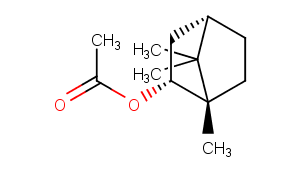(-)-Bornyl acetate
| Code | Size | Price |
|---|
| TAR-TN1448-500mg | 500mg | £104.00 | |||||||||||||||||||||||||||||||||||||||||||||||||||||||||||||||||||||||||||||||||||||||||||||||||
| Special offer! Add £1 to your order to get a TargetMol CCK-8 Kit. Read more here. | |||||||||||||||||||||||||||||||||||||||||||||||||||||||||||||||||||||||||||||||||||||||||||||||||||
Quantity:
| TAR-TN1448-1mL | 1 mL * 10 mM (in DMSO) | £107.00 | |||||||||||||||||||||||||||||||||||||||||||||||||||||||||||||||||||||||||||||||||||||||||||||||||
| Special offer! Add £1 to your order to get a TargetMol CCK-8 Kit. Read more here. | |||||||||||||||||||||||||||||||||||||||||||||||||||||||||||||||||||||||||||||||||||||||||||||||||||
Quantity:
| TAR-TN1448-1g | 1g | £117.00 | |||||||||||||||||||||||||||||||||||||||||||||||||||||||||||||||||||||||||||||||||||||||||||||||||
| Special offer! Add £1 to your order to get a TargetMol CCK-8 Kit. Read more here. | |||||||||||||||||||||||||||||||||||||||||||||||||||||||||||||||||||||||||||||||||||||||||||||||||||
Quantity:
Prices exclude any Taxes / VAT
Overview
Regulatory Status: RUO
Shipping:
cool pack
Storage:
-20℃
Images
Documents
Further Information
Bioactivity:
(-)-Bornyl acetate is a less active enantiomer of (+)-Bornyl acetate. (-)-Bornyl acetate isolates from hyssop oil and possesses antifungal activity. (-)-Bornyl acetate shows highly active whitening and antioxidant activities, has potential applications in cosmeceutical materials. (-)-Bornyl acetate downregulated the levels of proinflammatory cytokines in vitro and in vivo; reduced the number of total cells, neutrophils, and macrophages in BALF; attenuated the histologic alterations in the lung; decreased the wet-to-dry weight ratio in BALF; and suppressed NF-kappa-B inhibitor alpha, extracellular regulated protein kinases, c-JunN-terminal kinase, p38 mitogen-activated protein kinase activation.
CAS:
5655-61-8
Formula:
C12H20O2
Molecular Weight:
196.29
Pathway:
NF-κb; Microbiology/Virology; MAPK
Purity:
0.98
SMILES:
CC(=O)O[C@@H]1C[C@@H]2CC[C@@]1(C)C2(C)C
Target:
p38 MAPK; NF-κB; JNK; Antifungal
References
Chen N, et al. Inhibition of lung inflammatory responses by bornyl acetate is correlated with regulation of myeloperoxidase activity. J Surg Res. 2014 Jan;186(1):436-4
Jun-Ichiro Horiuchi, et al. Exposing Arabidopsis seedlings to borneol and bornyl acetate affects root growth: Specificity due to the chemical and optical structures of the compounds. Journal of Plant Interactions Volume 2, 2007 - Issue 2.
M. P. LETESSIER ETESSIE, et al. Antifungal Activity of the Essential Oil of Hyssop (Hyssopus offcinalis). J. Phytopathology 149, 673?678 (2001).



